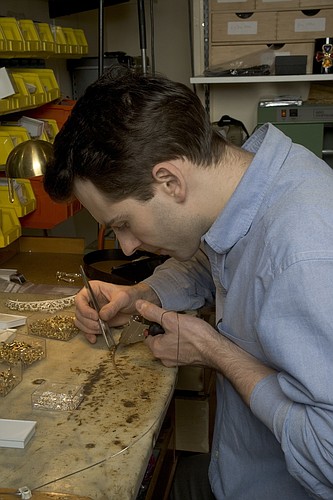- December 20, 2025
-
-
Loading

Loading

When it comes to period jewelry, Andrew Prince is both a one-man encyclopedia and a creative dynamo. He’s designed and created dazzling collections of historically accurate brooches, combs, earrings, necklaces and tiaras for “Downton Abbey,” “The Young Victoria” and other films and television programs. Prince also shares his multifaceted knowledge of the history, technology and social dynamics behind his creations as a popular lecturer around the world.
He’ll be bringing his multifaceted insights to our area during a lecture and trunk show, Thursday, Jan. 23, as part of the New Topics lecture series at New College.
Although Marilyn Monroe tells us diamonds are forever, Andrew Prince thinks that paste is much more fun. In our conversation, he was happy to explain why.
You create the jewelry of the imagined past. Of course, it’s really contemporary art. Is your artistry a form of creative time travel?
A literal copy of a historic object is very uncreative. They’re like those vintage car reproductions — they always looks a bit fake. I try to take elements from the past and create something that’s, in fact, contemporary. My creations are original, not copies.
How would you define those elements?
When creating jewelry for the past, you must first consider who’s wearing it and where. The most important consideration is a person’s age. Maggie Smith’s peak jewelry would reflect the best years of her character’s life in the Victorian or Edwardian eras. Lady Mary would be wearing the stuff that was modern for that day, which would be from the 1920s onward.
So, your period jewelry is a form of characterization.
Precisely. To be truly accurate, you must also consider a range of variables. In England, there were all sorts of do’s and don’ts. For some obscure reason, tiaras were considered incorrect for unmarried women. If a big townhouse held an event, the lady of the house would look magnificent in all her finery. But if they were hosting the queen or a princess, she’d take a smaller role — because you’d never want to outshine royalty.
You’ve said that jewelry shouldn’t be about cost. Why not?
Jewelry, when you get right down to it, is a decoration. It should be fun. You should enjoy it. That’s what I love about costume jewelry. You can have fun with paste, but you can’t have fun with real diamonds. Unless you’re designing pieces for the fabulously wealthy, there’s no room for creative risk. But with costume jewelry, you can get away with anything. It’s all about design and function.
Why do you love jewelry?
I love it for many reasons, but on a very basic level, I think because it sparkles. A friend of mine once compared me to Gollum. “You look at a piece of jewelry and say, ‘My precious, my precious.’” I suppose there’s some truth in that.
When did your love affair with jewelry begin?
Well, I swallowed a pair of my mother’s pearl earrings when I was 3. You could say I developed a taste for jewelry at a very early age.
How’d that happen?
Quite naturally. I found the jewelry box and in they went. But my obsession continued from there. I started making jewelry at age 5 or 6. I actually made my first piece for my grandmother. I found some copper wire and pulled off a few beads from her old wedding dress.
She wasn’t happy, but she kept the piece. My grandmother died a few months ago. But I’ve still got the original piece.
What can we expect at your New College talk?
Basically, I’ll be talking briefly about “Downton” and bringing many of the pieces I made for the show. I’ll look at the evolution of jewelry and fashion from 1890 to 1929, and explore why everything changed. It’s going to be a very fun journey.
What pieces from “Downton Abbey” are you particularly proud of?
Well, I never like to say I’m proud of something, but I do love Maggie Smith’s choker, the one she wore in the third and fourth season. I’ve been offered quite a bit of money for it. I’m not selling it. If anybody wants it, they’ll have dig for it because I plan to be buried with it.